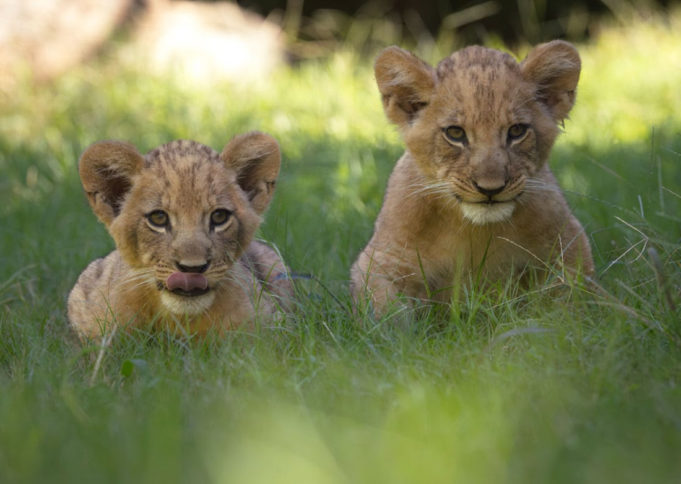Shortly after the sun rises and well before the crowds arrive, some of the most important work at the Fort Worth Zoo is already underway. Behind the scenes of the animals’ sprawling habitats, new lives are stirring.
As fall begins, a fresh season is beginning for a pair of African lion cubs and a female Asian elephant calf. The three babies are growing, learning, and becoming tangible connections to the future of two species.
In late June, the lion cubs’ story began away from public view, in a sheltered den where veteran mom Saba gave birth to a male and female on June 29, 2025.
Behind the scenes, keepers watched closely.
“Initially, the first thing you look for is, ‘Are they nursing?’ and ‘For how long?’ ” said Zach Butler, a keeper for the Predators of Asia & Africa exhibit. “The easiest way for us to monitor that is just weighing them every day to make sure they’re consistently growing.”
In the early days of their development, the cubs wrestled, tumbling over each other in a clumsy imitation of predator and prey. Their instincts quickly bloomed into distinct personalities.
The female cub, Imara (Swahili for “strength”), emerged as the bolder of the two as they played games like swatting at Saba’s tail, typical cub behavior. The male cub’s name is Tamu (“sweet”), a reflection of his gentler nature.
“He’s kind of a mama’s boy,” Butler said of Tamu, who rarely leaves his mother’s side.
Saba cares for them as an “ideal” lioness mom, patiently nursing and bathing them. The habitat was also “baby-proofed” with extra logs and lowered water levels for safety around the pools and waterfalls.
Beyond the habitat, the cubs have found an unexpected guardian in the pride’s stately male lion, Jabulani. The father is doing his part to provide a welcoming and smooth transition.
“He mostly just does his thing and sits around looking pretty,” Butler said. “He doesn’t really interact with them unless they interact with him first.”
When he does, Jabulani provides gentle, playful care.
“A good sign the dad is OK with his cubs is rolling over with them,” Butler said. “He’s showing sensitive parts like his stomach, like he’s willing to be vulnerable.”
A Genetic Legacy
The cubs are part of an overarching goal to diversify lion genetics in the United States. In the wild, lions have a “vulnerable” conservation status, according to the International Union for Conservation of Nature (IUCN).
Fort Worth Zoo belongs to a cooperative breeding program among North American zoos which is designed to establish a genetically diverse population of African lions. Adult lions Jabulani, Saba, and Abagabae were born at a South African wildlife facility and came to the Fort Worth Zoo in 2012. Their arrival introduced new bloodlines of lions into North America and varied the gene pool, the zoo said.
“When [the lions] got here, their genetic representation in the U.S. population was basically zero,” Butler said. “There were no lions related to them, which makes them extremely important.”
The new cubs are playing another important role, as well: keeping the pride active. Lions can sleep 16 to 20 hours a day, Butler noted. While the cubs are running around, they also get the adult lions up and moving.
For now, an older sibling, Moja, stays in a private habitat to avoid any roughhousing. Born Oct. 20, 2023, Moja is still a bit of a “big baby” who likes to play and can be very rambunctious, Butler said.
A Spunky Matriarch in the Making
The biggest baby of all, though, is making her own impression at the nearby Elephant Springs habitat. On Aug. 18, 2025, a 250-pound female calf was born to Bluebonnet, the first elephant calf ever born at the Fort Worth Zoo, in 1998. The new calf makes the herd’s matriarch, Rasha, a great-grandmother — a rare title for an Asian elephant in North America.
Signs of a healthy calf were immediate: The zoo said she was standing within six minutes and nursing within two hours. After an 11-day naming contest with around 18,000 votes, the calf has been named Lady Bird, after former First Lady and Texas native Claudia Alta “Lady Bird” Johnson, who loved nature and wildflowers and advocated for native plants and ecosystems. For weeks, mother and daughter bonded quietly behind the scenes, a crucial period for the calf’s development.
Lady Bird is proving to be active and intelligent.
In the wild, elephants live in matriarchal herds, a dynamic the zoo replicates. The new calf has met all the females and has even reached out with her trunk to touch the male elephants as they walk by in a separate habitat.
“In the wild, the ladies all live together,” Gabby McGee said. “Adult males are pretty solitary and don’t have any part of child rearing.”
Often, a calf’s traits are shaped by whichever elephant it’s around the most.
“They can in fact pick up different personality traits,” McGee said. “Whoever they spend a lot of time with, they will emulate that elephant.”
While people often project human emotions onto animals, the keepers strive to understand them on their own terms.
“They don’t think like a human. They think like an elephant,” McGee said. “We love elephants just as they are.”
The calf’s birth is a reminder of the IUCN’s endangered status of Asian elephants, with as few as 40,000 remaining in the wild. For her keepers, the calf is a living link to a species many may never see in its natural habitat.
“I’ve never been to Asia,” McGee said. “I’ve never been to Africa, but I love elephants. It’s their intelligence and the personal relationships we build with them.”

Photo by Teri Webster
Below is a listing of some of the baby animals born in recent years at Fort Worth Zoo. Up-to-date information on all the animals and their viewing times is available at FortWorthZoo.org.
Latest Baby Animals Born at Fort Worth Zoo
African lion
Imara and Tamu — born Jun. 29, 2025
Moja — born Oct. 20, 2023
Asian elephant
Lady Bird — born Aug. 18, 2025
Travis — born Feb. 23, 2023
Brazos — born Oct. 21, 2021
Mandrill
Jasper — born Sep. 13, 2024
Ruby — born Jan. 11, 2024
Reticulated Giraffe
Finnigan — born Aug. 18, 2024
Delilah — born Jul. 2, 2024
Ace — born Apr. 1, 2024
Korbel — born Jan. 1, 2024
Colobus Monkey
Baloo — born Jan. 24, 2024
Corey — born Oct. 29, 2023
Gharial
Hatchlings were born on Jun. 5 and on Jun. 11, 2025. Hatchlings were also born in 2023 and 2024.
Western Lowland Gorilla
Bruno — born Nov. 6, 2022












